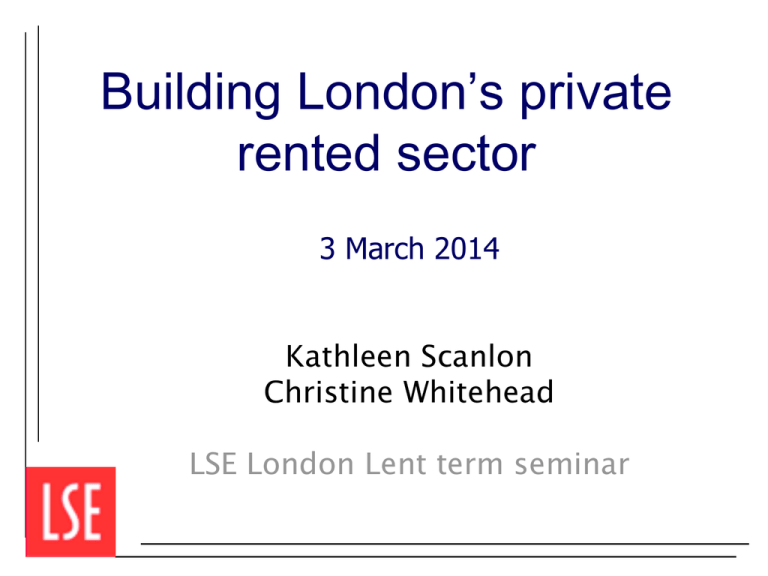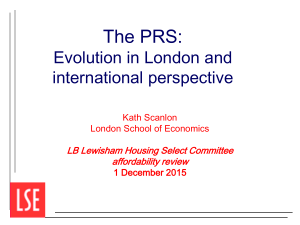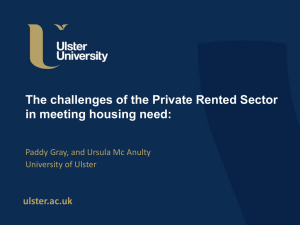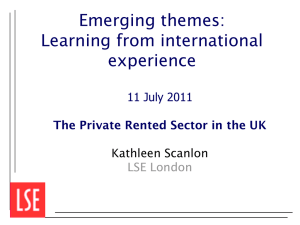Building London’s private rented sector 3 March 2014 Kathleen Scanlon
advertisement

Building London’s private rented sector 3 March 2014 Kathleen Scanlon Christine Whitehead LSE London Lent term seminar Some recent headlines Councils urged to build homes for private rent Local councils should set targets for building homes for the private rented sector, says new report (Telegraph 24/2) A better private rented sector can weed out rogue landlords for good It's the fastest growing area of the market, but rented homes are dominated by amateur landlords. It's time for that to change (Guardian 26/2) We need rent controls to solve London's housing crisis Too many essential workers are being priced out of the capital. Rent controls could address the uncertainty and unaffordability they face (New Statesman 27/2) Historic PRS provision in London: Du Cane Court Dolphin Square What happened? • Post-deregulation (starting in the 1950s) companies wanted to sell – and did over the next twenty years • Owner-occupation grew rapidly with welldeveloped leasehold arrangements and the possibility of buying long leases • Tax benefits and other incentives meant private sector building was almost always for owner-occupation • New rented housing provided in the social sector Decline and revival • PRS declined to 11% of total stock in England by the mid-1980s • Deregulation of rents in 1988 led to slow increase in supply • Owner-occupation for young people badly hit in early 1990s • Buy-to-Let mortgages introduced in late 1990s – PRS started to increase quite quickly • Affordability crisis in early 2000s added to pressure on PRS The financial crisis and its aftermath • Credit and housing markets dried up • Sellers could not sell; purchasers could not buy – so PRS grew rapidly • New construction fell by more than half; while • Immigration and natural growth increased the population of London very rapidly • Crisis of supply with all net growth concentrated in PRS and among individual amateur/part-time landlords • Policy makers looked for more housing overall and new build in PRS in particular Figure 1: Housing tenure, London Compared to USA: the perception UK USA Individual landlords Corporate landlords Most owning 1-5 units (not buildings) Dwellings originally built for sale to occupiers or as social housing Owning multi-family developments Funded by buy-to-let mortgages Amateurs Purpose-built for rental Funded by commercial loans Professionals Current UK policy direction • Encourage construction of rental developments – to provide big investments for institutions, – allow faster construction on large sites, – introduce specific features suited to rentals • Attract more institutional investors – to bring professionalism and financial stability • National subsidies specific to PRS – Build to Rent Fund – Investor guarantees for debt finance What barriers must be overcome? • Attracting institutions to the sector has long been the holy grail • Institutions have argued that yield is too low and that owner-occupation will always be more profitable and will therefore determine land prices • Has the world changed? Decision-making by developers and investors The developer: Land price = gross development value – build cost – required profit The investor: Yield = Income / asset price Investor’s net income made up of revenue… Revenue Number of units Rent per unit Annual rent increase Yield = Income / asset price ( Yield = Income / asset price ) Voids …less costs Average tenant length of stay Average time to find new tenant Re-lets Average cost of refurb between tenants Cost of marketing Property supervision, including letting and running the property Management Rent collection Arrears and bad debts Repairs and maintenance Other costs Insurance Service charge and ground rents Utilities ( Yield = Income / asset price ) Risks add to required yield. Some fairly easy to price: Planning risk Development risk Initial letting Operating or management risk Add X% (say 15-20%) for land and planning risk to required returns to developers Add 5% for construction risk Little experience with large-scale rental developments on which to base estimates Add x% for operational risk to investor model OR require rent guarantee from AA counterparty ( Yield = Income / asset price ) Others less so Will investor be able to sell—to ownerExit risk occupiers or another investor? Reputational Problem tenants, bad management, more general issues with PRS risk Policy or regulatory risk Will rent control or security of tenure be reimposed? (Yield = Income / asset price) Barriers related to land, construction and product • Value of land driven by owner-occupation • Supply of land (particularly in London) in the right location • Local authority policies (Mayoral policies vs those of boroughs) • Lack of development finance Barriers related to yield • Illiquidity of residential property • Lack of robust market information • Management • Scale of potential investment Barriers related to investor attitudes • Predictability of demand into the longer term • Investors not willing to take planning/development risk • Investors’ mandates (industry benchmarks) • Reputational risks • Regulatory and policy risks • Lack of expertise within investment houses Have the barriers to investment been overcome? • Few dedicated new PRS developments to date—but increasing interest • Government programmes starting to bear fruit • Mayor’s Draft Housing Strategy calls for 5,000 per annum specifically for the PRS • Possible introduction of covenanted PRS – but benefit of mixed sites? • Experience of the early adopters (QDD, Genesis etc) will be crucial East Village (former Olympic athletes’ village) Stratford Halo Conclusions • Many of the barriers reflect very specific features of the UK planning system and property market, and will be slow to change • Even so, best opportunity in decades for genuine shift in PRS provision – but only at the margin • Champions or first movers will be key -- many from overseas


